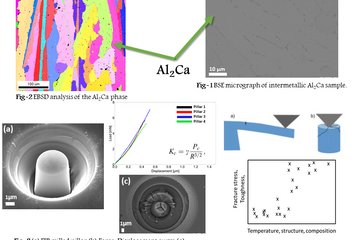All genres
1.
Journal Article
Error analysis of the crystal orientations and disorientations obtained by the classical electron backscatter diffraction technique. Journal of Applied Crystallography 48 (3), pp. 797 - 813 (2015)
2.
Journal Article
Lattice strain across Na–K interdiffusion fronts in alkali feldspar: An electron back-scatter diffraction study. Physics and Chemistry of Minerals 41 (10), pp. 795 - 804 (2014)
3.
Journal Article
Revealing the strain-hardening behavior of twinning-induced plasticity steels: Theory, simulations, experiments. Acta Materialia 61 (2), pp. 494 - 510 (2013)
4.
Journal Article
Elastic properties of face-centred cubic Fe–Mn–C studied by nanoindentation and ab initio calculations. Acta Materialia 60 (17), pp. 6025 - 6032 (2012)
5.
Talk
Optimizing of cross-correlation methods for local residual stress measurements in slightly tensile deformed twip steels. Euromat 2013, Sevilla, Spain (2013)
6.
Talk
Quantitative Microstructure Characterization by Application of Advanced SEM-Based Electron Diffraction Techniques. Microscopy and Microanalysis 2013, Indianapolis, IN, USA (2013)
7.
Talk
Interpretation of cross‐correlation results (Wilkinson method) for local residual stress measurements in slightly tensile deformed TWIP steels. RMS EBSD 2013, Oxford, UK (2013)
8.
Talk
Electron Diffraction in Scanning Electron Microscope and its applications. Institut für Werkstofftechnik, Helmut Schmidt Universität, Hamburg, Germany (2012)
9.
Talk
Grundlagen der Kreuzkorrelationsmethode (delta-EBSD): Einführung in CrossCourt3 (CC3) und Erfahrungen in der praktischen Anwendung von CC3. Seminar Talk at Arbeitskreis EBSD in Garbsen, Garbsen, Germany (2012)
10.
Talk
Residual stress prediction by considering dislocation density advection in 3D applied to single-crystal bending. Euromat 2011, Montpellier, France (2011)
11.
Talk
Detailed observation of martensite transformation and twinning in TRIP and TWIP steels using advanced SEM diffraction techniques. ICOMAT 2011, Osaka, Japan (2011)
12.
Talk
Residual stress prediction by considering dislocation density advection in 3D applied to single-crystal bending. 2nd International Conference on Material Modelling ICMM 2, Paris, France (2011)
13.
Poster
Error Analysis of the Crystal Orientations and Misorientations obtained by the Classical Electron Backscatter Diffraction Method. RMS EBSD 2014, London, UK (2014)
14.
Poster
On the accuracy and precision of orientations obtained by the conventional automated EBSD method. RMS EBSD 2014, London, UK (2014)
15.
Thesis - PhD
Feasibility study on local elastic strain measurements with an EBSD pattern cross correlation method in elastic-plastically deforming material. Dissertation, RWTH Aachen, Aachen, Germany (2014)











